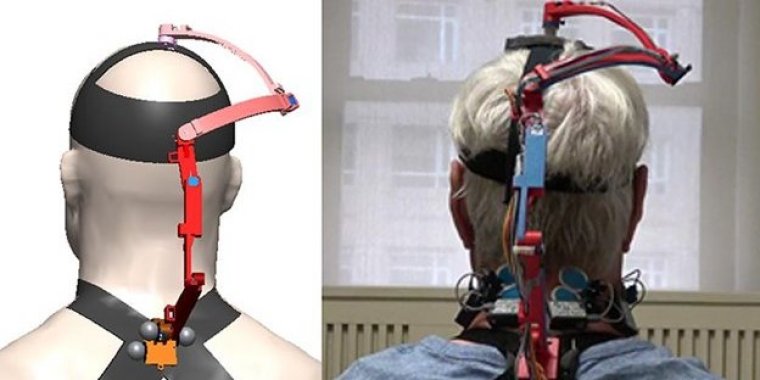| Health / Health News |
Robotic neck brace can help analyze cancer treatment impacts
A new robotic neck brace developed by researchers at Columbia University Engineering and colleagues at Columbia's Department of Otolaryngology may help doctors analyze the impact of cancer treatments on the neck mobility of patients and guide their recovery.

Schematic of the new robotic neck brace and a picture of a subject using the brace. Photo: Columbia Engineering
Head and neck cancer was the seventh most common cancer worldwide in 2018, with 890,000 new cases and 450,000 deaths accounting for 3% of all cancers and more than 1.5% of all cancer deaths in the United States.
The cancer can spread to lymph nodes in the neck, as well as other organs in the body.
Surgically removing lymph nodes in the neck can help doctors investigate the risk of spread but may result in pain and stiffness in the shoulders and neck for years afterward.
Identifying which patients may have issues with neck movement "can be difficult, as the findings are often subtle and challenging to quantify," said surgeon Scott Troob of Columbia University Irving Medical Center.
However, successfully targeting what difficulties they might have with mobility can help patients benefit from targeted physical therapy interventions, he said.
The current techniques and tools doctors use to judge the range of motion a patient may have lost in his or her neck and shoulders are somewhat crude, said Sunil Agrawal, a mechanical engineer and rehabilitative and regenerative medicine specialist at Columbia Engineering.
They often provide unreliable measurements or require too much time and space to set up for use in routine clinical visits, Agrawal said.
To develop a more reliable and portable tool to analyze neck mobility, Agrawal and colleagues drew inspiration from a robotic neck brace they previously developed to analyze head and neck motions in patients with amyotrophic lateral sclerosis, or ALS.
In partnership with Troob's group, they have now designed a new wearable robotic neck brace.
"This is the first research of this kind where a wearable robotic neck brace has been designed to characterize the full head and neck range of motion," Agrawal said. (National Science Foundation)
YOU MAY ALSO LIKE





